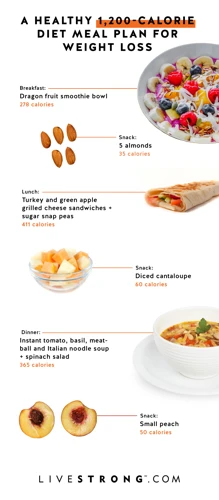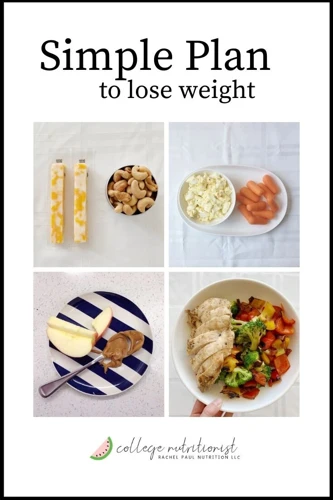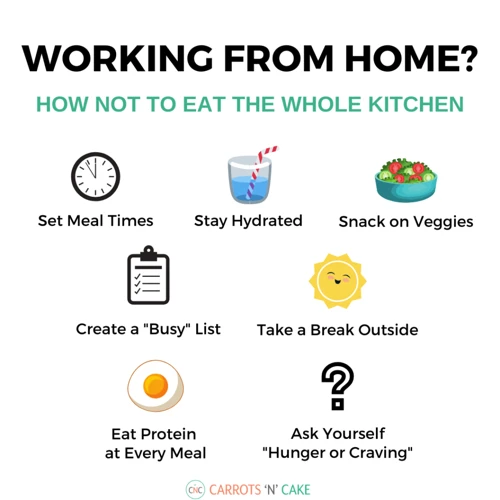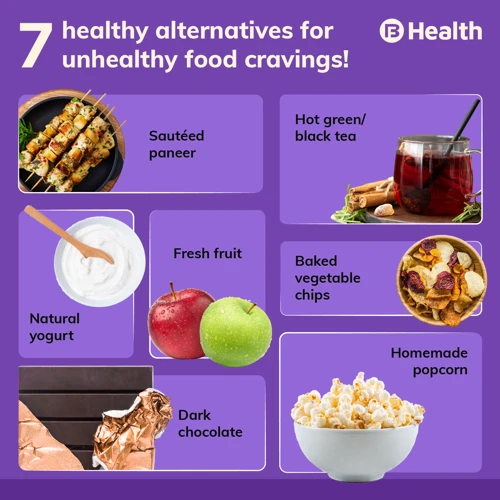Many of us have experienced that sudden urge to eat something, even when we’ve just had a meal. These intense cravings can often lead to unhealthy snacking and overeating, leading to an imbalance in our diet and an increase in our waistline. However, there are ways to battle these hunger pangs and prevent cravings by planning your meals in a strategic manner. In this guide, we’ll explore the steps you can take to plan meals that satisfy your hunger, keep you full for longer, and prevent those mid-day cravings that can sabotage your healthy eating goals. Let’s get started!
Understand Your Caloric Needs

Before you can start planning meals that satisfy your hunger and prevent cravings, it’s important to understand your body’s caloric needs. Knowing how many calories you need each day can help ensure that you’re fueling your body properly without overeating or undereating. With a few simple tools and strategies, you can easily determine your daily caloric needs and use this information to plan meals that support your health and wellbeing. Let’s explore some methods for calculating your caloric needs and tracking your food intake.
Determine Your Daily Caloric Needs
One of the first steps in planning meals to satisfy hunger and prevent cravings is determining your daily caloric needs. This information will help you create a meal plan that matches your lifestyle and helps you achieve your health goals. Here’s how you can determine your daily caloric needs:
Step 1: Calculate Your Basal Metabolic Rate (BMR)
Your basal metabolic rate (BMR) is the amount of energy your body requires to function at rest. It’s the minimum amount of calories you need to sustain basic bodily functions such as breathing, circulation, and cellular metabolism. There are several formulas you can use to calculate your BMR, such as the Mifflin-St Jeor equation, the Harris-Benedict equation, and the Katch-McArdle formula. Here’s an example using the Harris-Benedict equation:
| BMR Calculation for Women: | 655 + (4.35 x weight in pounds) + (4.7 x height in inches) – (4.7 x age in years) |
| BMR Calculation for Men: | 66 + (6.23 x weight in pounds) + (12.7 x height in inches) – (6.8 x age in years) |
Step 2: Factor in Your Physical Activity Level
The next step is to factor in your physical activity level, as this can significantly impact your daily caloric needs. If you have a sedentary lifestyle and don’t engage in any physical activity, you’ll need fewer calories than someone who exercises regularly. Use the following chart as a guideline to estimate your daily caloric needs based on your activity level:
| Sedentary | Little to no exercise | BMR x 1.2 |
| Lightly Active | Light exercise or sports 1-3 days per week | BMR x 1.375 |
| Moderately Active | Moderate exercise or sports 3-5 days per week | BMR x 1.55 |
| Very Active | Hard exercise or sports 6-7 days per week | BMR x 1.725 |
| Extra Active | Very hard exercise or sports, physical job, or training twice a day | BMR x 1.9 |
Once you’ve calculated your daily caloric needs, you can start planning your meals accordingly. Keep in mind that these are just estimates and should be adjusted based on your personal needs and goals. By determining your daily caloric needs, you’ll have a better understanding of how much food your body needs to function optimally, which can help you prevent overeating and reduce cravings.
Use a Food Tracking App
One effective method for understanding your caloric needs is to track your food intake using a food tracking app. These apps can help you monitor your caloric intake and identify where you may need to make adjustments. Here are some popular food tracking apps to consider:
| App Name | Features |
|---|---|
| MyFitnessPal | – Calorie tracking – Barcode scanner – Customizable goals |
| Lose It! | – Calorie tracking – Recipe builder – Community support |
| Fooducate | – Nutrition grading – Product recommendations – Recipe ideas |
Using a food tracking app allows you to input your meals and snacks throughout the day, providing you with a breakdown of the calories, macronutrients (protein, carbohydrates, and fat), and micronutrients (vitamins and minerals) you consume. This information can help you make more informed choices when planning your meals.
It’s important to note, however, that while these apps can be helpful, they should not be relied on as the sole source of information. It’s still essential to understand your own body and to listen to its hunger and fullness signals. By combining the information from a food tracking app with your personal experiences and knowledge, you can create a meal plan that truly satisfies your hunger and prevents cravings.
Choose Foods That Keep You Full

One of the keys to planning meals that satisfy your hunger and prevent cravings is to choose the right foods. If you want to avoid feeling famished soon after eating or constantly snacking throughout the day, it’s important to focus on foods that keep you full. By incorporating protein, fiber, and nutrient-dense options into your diet, you can stay satisfied for longer periods of time and reduce the likelihood of turning to unhealthy snacks. In this section, we’ll explore some key strategies for selecting the right foods to keep you on track towards meeting your goals.
Include Protein in Every Meal
In order to stay full and satisfied, it’s important to include protein in every meal. Protein is essential for building and repairing muscles, and it can help keep you feeling full for longer periods of time. Here are some great sources of protein to include in your meals:
| Protein Source | Protein Content |
|---|---|
| Chicken Breast | 24 grams per 3 ounces |
| Salmon | 17 grams per 3 ounces |
| Greek Yogurt | 18 grams per 6 ounces |
| Eggs | 6 grams per egg |
| Lentils | 9 grams per half cup cooked |
| Nuts | 6-7 grams per ounce |
Including protein in every meal can also help prevent overeating and cravings later on in the day. Don’t forget that protein doesn’t just have to come from animal products – there are plenty of plant-based sources of protein as well. Try incorporating some of these protein-rich foods into your meals to keep hunger at bay.
Focus on Foods High in Fiber
Fiber is an essential nutrient that plays a crucial role in digestion and can help keep you feeling full for longer periods. When planning your meals, it’s important to focus on including foods rich in fiber to help satisfy hunger and prevent cravings.
Here are some high-fiber foods to consider:
| Food | Fiber Content |
|---|---|
| Whole grains (brown rice, quinoa, oatmeal) | 2-8 grams per serving |
| Legumes (beans, lentils, chickpeas) | 6-10 grams per serving |
| Nuts and seeds (almonds, chia seeds, flaxseeds) | 3-8 grams per serving |
| Fruits (raspberries, blackberries, apples with skin) | 2-4 grams per serving |
| Vegetables (broccoli, spinach, Brussels sprouts) | 2-4 grams per serving |
Incorporating high-fiber foods into your meals not only helps keep you full, but also has numerous health benefits, including reduced risk of chronic diseases such as heart disease and type 2 diabetes. Be sure to aim for a variety of high-fiber foods throughout the day to reap the most benefits.
Pick Nutrient-Dense Foods
Nutrient-dense foods are those that provide a high amount of nutrients, such as vitamins and minerals, in relation to their calorie content. Making sure your meals include nutrient-dense foods can help you feel satisfied and prevent cravings.
Here are some examples of nutrient-dense foods:
| Food | Nutrients |
| Spinach | Iron, calcium, vitamin A, vitamin K |
| Salmon | Omega-3 fatty acids, vitamin D, vitamin B12, protein |
| Blueberries | Antioxidants, fiber, vitamin C, vitamin K |
| Quinoa | Protein, fiber, magnesium, iron |
| Almonds | Healthy fats, vitamin E, magnesium, protein |
Incorporating these types of nutrient-dense foods into your meals can provide a variety of health benefits. For example, getting enough iron from sources like spinach can help prevent anemia, while consuming foods with omega-3 fatty acids, such as salmon, can support heart health.
When planning your meals, focusing on nutrient density can help ensure you’re providing your body with the necessary vitamins and minerals, without over-consuming calories.
Plan Your Meals Ahead of Time

One of the keys to successfully managing hunger and preventing cravings is planning your meals in advance. By taking the time to plan out your meals, you’ll be able to ensure that you have healthy, satisfying options on hand when hunger strikes. Additionally, planning ahead can save you time and stress by eliminating the need to scramble for meal ideas at the last minute. Let’s explore some tips for effective meal planning.
Prep Meals in Advance
One key way to plan meals that will help satisfy hunger and prevent cravings is to prep meals in advance. By doing this, you’ll be able to save time during the week and ensure that you have healthy meals ready to go.
Meal prep tips:
| 1. Choose a day to meal prep | Set aside one day each week to plan and prepare your meals for the upcoming week. This can be a time-saving strategy that will help you stay on track with your healthy eating goals. |
| 2. Plan your meals | Before you start cooking, plan out your meals for the week. This will help you create a grocery list and save time at the store. You can also try prepping some freezer meals for future weeks. |
| 3. Cook in batches | To save time, cook in batches. For example, if you’re cooking chicken, cook a large batch and use it in different meals throughout the week. This will help you avoid getting bored with your meals. |
| 4. Use appropriate storage containers | Choose storage containers that are appropriate for the type of food you’re prepping. For example, glass containers are great for salads, while plastic containers are better for soups and stews. Use labels to help you easily identify what’s in each container. |
| 5. Store food properly | Store your prepped meals in the refrigerator or freezer to help them last longer. Be sure to place them in a visible location so you remember to eat them. |
By prepping your meals in advance, you’ll be able to make healthy choices throughout the week without spending too much time in the kitchen. Plus, having prepped meals on hand will help reduce the temptation to eat unhealthy food when you’re short on time.
Make a Grocery List
Planning your meals ahead of time is essential when it comes to satisfying your hunger and preventing cravings. Making a grocery list is a key part of that process. By taking the time to plan out what you need to buy before heading to the grocery store, you can ensure that you have all the ingredients you need to make healthy meals and snacks throughout the week.
To make the most of your grocery trip, start by identifying the ingredients you need for the meals you have planned. This might require reviewing your recipes or meal plan to ensure you don’t forget anything. Once you know what you need, organize your list so that it follows the layout of your grocery store. This can help you save time and avoid backtracking as you shop.
Below is an example of how you can use an HTML table to create a well-organized and efficient grocery list:
| Category | Items |
|---|---|
| Produce |
|
| Dairy |
|
| Protein |
|
| Grains |
|
| Snacks |
|
By organizing your grocery list in this way, you can easily navigate the store and ensure that you don’t forget anything. This can also help you resist the temptation to purchase unhealthy snacks or convenience foods that can derail your healthy eating plans.
Taking the time to make a grocery list is an important step in planning meals that can help you satisfy hunger and prevent cravings. By approaching your grocery trip with a clear plan and a well-organized list, you can set yourself up for success in sticking to a healthy eating routine.
Stick to a Schedule

One of the most important keys to successful meal planning is having a consistent schedule. Having a routine helps regulate your appetite, prevents overeating and can also help you maintain cognitive function throughout the day. In this section, we’ll explore some tips and strategies to help you stick to a schedule that works best for your body and lifestyle.
Establish a Regular Eating Schedule
Establishing a regular eating schedule is crucial for keeping your hunger and cravings under control. By sticking to a routine, your body can get into a rhythm and better predict when it will receive nourishment. This can prevent situations where you feel famished and end up overeating or reaching for unhealthy snacks.
One way to establish a regular eating schedule is to plan out your meals and snacks ahead of time. Use a meal planning app or simply jot down what you will eat and at what time. This will help keep you accountable and ensure that you are not skipping meals or snacking excessively.
Another important aspect of a regular eating schedule is spacing out meals and snacks throughout the day. Instead of having three large meals, try breaking up your food intake into smaller, more frequent meals. This will help keep your blood sugar levels stable and prevent sudden drops in energy.
To give you an idea of what a regular eating schedule could look like, take a look at the sample table below:
| Meal/snack | Time |
|---|---|
| Breakfast | 7:00 am |
| Morning snack | 10:00 am |
| Lunch | 12:30 pm |
| Afternoon snack | 3:00 pm |
| Dinner | 6:00 pm |
| Evening snack | 8:30 pm |
Remember that everyone’s schedule will look different, so feel free to adjust the times and number of meals/snacks to fit your lifestyle. The key is to find what works best for you and stick to it consistently.
Avoid Skipping Meals
Skipping meals is a common mistake people make when trying to lose weight or manage their hunger. However, skipping meals can actually backfire and lead to overeating later on. Here are some reasons why you should avoid skipping meals:
- Slows down metabolism: When you skip meals, it sends a message to your body that it needs to conserve energy. As a result, your metabolism slows down, making it harder to burn calories.
- Increases cravings: Skipping meals can cause your blood sugar levels to drop, which can lead to intense cravings for sugary or high-calorie foods.
- Impairs decision-making skills: When you’re hungry, your ability to make rational decisions can be compromised. This can lead to poor food choices and overeating.
- Reduces energy levels: Skipping meals can leave you feeling tired and lethargic, which can make it harder to stick to a healthy eating plan or engage in physical activity.
To avoid skipping meals, make sure to plan your meals ahead of time and have healthy snacks on hand for when hunger strikes. Aim to eat every few hours to keep your metabolism revved up and your cravings under control. Remember, consistency is key when it comes to maintaining a healthy eating schedule.
Stay Hydrated

Proper hydration is essential to overall health and well-being. It’s important for maintaining a healthy weight, keeping your energy levels up, and even regulating your body temperature. However, many people are not aware of how much water they should be drinking or how to make sure they are staying hydrated throughout the day. In this section, we will explore some tips and strategies for staying properly hydrated and avoiding the negative effects of dehydration.
Drink Plenty of Water
Staying hydrated is important for overall health and can also help prevent you from overeating. Aim to drink plenty of water throughout the day, especially before and after meals. Thirst is often mistaken for hunger, so staying hydrated can help you better gauge your hunger levels and prevent unnecessary snacking. Here are some tips to increase your water intake:
- Keep water readily available: Make sure you always have a water bottle or glass of water within reach throughout the day, whether at home or at work.
- Infuse your water with flavor: If plain water isn’t appealing to you, add some natural flavor by infusing it with fresh fruit or herbs.
- Drink water before meals: Drinking a glass of water before meals can help you feel fuller and reduce the desire to overeat.
- Track your water intake: Use a water tracking app or simply mark your water bottle with time goals to ensure you are drinking enough throughout the day.
In addition to drinking water, it’s important to limit sugary drinks such as soda, fruit juice, and energy drinks. These beverages are often high in calories and can contribute to weight gain and increased sugar cravings. Instead, opt for water, herbal tea, or other sugar-free drinks.
Limit Sugary Drinks
It’s important to limit sugary drinks in order to maintain a healthy and balanced diet. Sugary drinks not only add extra calories to your daily intake, but they can also lead to a spike in blood sugar levels and cravings for more unhealthy foods. Here are some tips for limiting sugary drinks:
- Avoid soda: Soda is one of the biggest culprits when it comes to sugary drinks. One can of soda can contain up to 39 grams of sugar. Swap out soda for flavored water, fruit-infused water or herbal tea instead.
- Read labels: Be sure to read the labels of bottled drinks before purchasing them. Some may contain hidden sugars, even drinks that are marketed as “healthy” or “all-natural”. Choose beverages with little to no added sugar.
- Drink water: The best way to stay hydrated is by drinking water. It has zero calories and is essential for many bodily functions.
- Limit juice intake: While juice may seem like a healthy choice, it can contain just as much sugar as soda. If you must have juice, dilute it with water or choose a juice with no added sugars.
- Try alternative sweeteners: If you must sweeten your beverages, try using alternative sweeteners like stevia, honey or maple syrup. They are healthier than sugar and won’t cause the same sugar crashes.
By following these tips and limiting your intake of sugary drinks, you will be able to maintain a healthier diet and reduce your cravings for unhealthy foods.
Avoid Trigger Foods
If you’ve ever found yourself reaching for a tub of ice cream or a bag of chips during a stressful or emotional time, you know how powerful trigger foods can be. These are the foods that you turn to when you’re feeling down or in need of comfort, even if you know they’re not the best choice for your health. Avoiding trigger foods is an important part of planning your meals to satisfy hunger and prevent cravings. By understanding what triggers your cravings and finding healthier alternatives, you can take control of your eating habits and make choices that support your overall well-being.
Identify Your Trigger Foods
One important step in preventing cravings and staying on track with healthy eating is recognizing and avoiding trigger foods. These are foods that can cause you to overeat or make unhealthy choices. Below is a table outlining ways to identify your trigger foods:
| Strategy | Description |
|---|---|
| Journaling | Keep a food journal and note how you feel after eating certain foods. Look for patterns of overeating or cravings. |
| Sensitivity Testing | Some people may have sensitivity to certain foods. Consider eliminating common allergens such as dairy or gluten for a few weeks to see if your cravings improve. |
| Emotional Triggers | Some people may reach for certain foods when feeling stressed or emotional. Take note of what foods you turn to in these situations. |
| Physical Cravings | Some people may have cravings for specific foods due to nutrient deficiencies or imbalances. If you find yourself regularly craving something, research what nutrients that food may be providing and consider adjusting your diet accordingly. |
By identifying your trigger foods, you can begin to make healthier choices and avoid the temptation to overindulge. Consider keeping these foods out of your home and finding healthier alternatives to replace them. Remember, it’s okay to indulge in moderation, but being aware of your triggers can help you stay on track towards a healthier lifestyle.
Keep Trigger Foods Out of Sight
When it comes to avoiding trigger foods, “out of sight, out of mind” is a helpful mindset to adopt. Keeping trigger foods out of sight can significantly reduce the likelihood of giving into cravings. One way to do this is by organizing your pantry and fridge in a strategic manner.
Consider grouping healthier options at eye level and placing “junk” foods in harder to reach places. Additionally, storing healthier snacks such as carrot sticks or cucumbers in clear containers at eye level can make them more appealing and easy to reach.
It’s also important to take note of which trigger foods are commonly tempting for you personally. For example, if chocolate is a weakness, keeping a candy jar on your kitchen counter is not the best idea. Instead, consider storing chocolate in a higher cupboard that requires a stool or ladder to reach.
Ultimately, keeping trigger foods out of sight is an effective approach for preventing temptations and staying on track with your meal plan. By deliberately setting up your environment, you can help yourself make better food choices and avoid falling off the wagon.
| Do: | Don’t: |
|---|---|
|
|
Find Healthier Alternatives
One way to prevent cravings is to find healthier alternatives to your trigger foods. Instead of reaching for candy or other sweets, try to find alternatives that are just as satisfying but are also nutrient-dense. Here are some options:
- Swap candy for fruit: Instead of indulging in candy, opt for a piece of fruit such as an apple, banana, or berries. These naturally sweet options will still satisfy your sweet tooth while also providing necessary nutrients and fiber.
- Trade chips for veggies: Instead of snacking on chips, try cutting up some veggies like carrots, cucumber, or bell peppers. These crunchy options will provide you with healthy fiber and vitamins, without the added empty calories of chips.
- Choose whole grains over white: Instead of refined grains like white bread or pasta, opt for whole grain alternatives like brown rice, quinoa or whole wheat bread. These options are higher in fiber and will keep you feeling full for longer.
- Switch to healthier fats: Instead of reaching for fried foods or snacks high in saturated fats, choose healthier options like nuts, seeds, or avocado. These are rich in monounsaturated fats which are healthy for the body and can help keep hunger at bay.
By finding healthier alternatives, you can still enjoy delicious snacks and meals without sacrificing your health or giving into cravings.
Conclusion
After following the steps outlined in this article, you should have a solid foundation for planning meals that will satisfy your hunger and prevent cravings. By understanding your caloric needs and tracking your food intake, you can ensure you’re eating the right amount each day. Choosing foods that keep you full, such as those high in protein and fiber, and prepping meals in advance will make it easy to stick to your plan. Establishing a regular eating schedule, staying hydrated, and avoiding trigger foods will also help you stay on track. Remember to be patient with yourself as you make changes to your diet and listen to your body’s cues of hunger and fullness. With these tips, you’ll be on your way to a healthier, more satisfying relationship with food.
Frequently Asked Questions
How many calories should I eat per day?
The number of calories you should eat per day depends on your age, gender, weight, height, and activity level. To determine your daily caloric needs, use an online calculator or consult with a registered dietitian.
What is a food tracking app?
A food tracking app is an app that allows you to log and track what you eat, including calorie intake, macronutrient breakdown, and more. Some popular food tracking apps include MyFitnessPal, Lose It!, and Fitbit.
Why is protein important?
Protein is important for maintaining and repairing the body’s tissues, building muscle mass, and keeping you feeling full and satisfied after meals.
What are some high-fiber foods?
High-fiber foods include fruits, vegetables, whole grains, nuts, seeds, and legumes.
Why is planning meals ahead of time important?
Planning meals ahead of time allows you to make healthier choices and avoid impulsively reaching for unhealthy snacks or fast food options. It also helps you save time and money.
What are some good meal prep ideas?
Good meal prep ideas include making overnight oats for breakfast, prepping salads for lunch, grilling or roasting chicken for protein, and roasting vegetables for easy side dishes.
What should I do if I’m not hungry at a designated meal time?
If you’re not hungry at a designated meal time, listen to your body and don’t force yourself to eat. However, try to keep to a regular eating schedule as much as possible to maintain consistent energy levels.
How much water should I drink per day?
The amount of water you should drink per day varies depending on your age, gender, weight, and activity level. A general guideline is to drink at least eight 8-ounce glasses of water per day.
What are trigger foods?
Trigger foods are foods that can cause you to overeat or lead to unhealthy cravings. They vary from person to person, but common trigger foods include high-fat and high-sugar foods.
How can I find healthier alternatives to my favorite trigger foods?
You can find healthier alternatives to your favorite trigger foods by experimenting with recipes and substituting ingredients. For example, you can swap out potato chips for baked sweet potato chips, or make a healthier version of mac and cheese with whole grain pasta and reduced-fat cheese.







